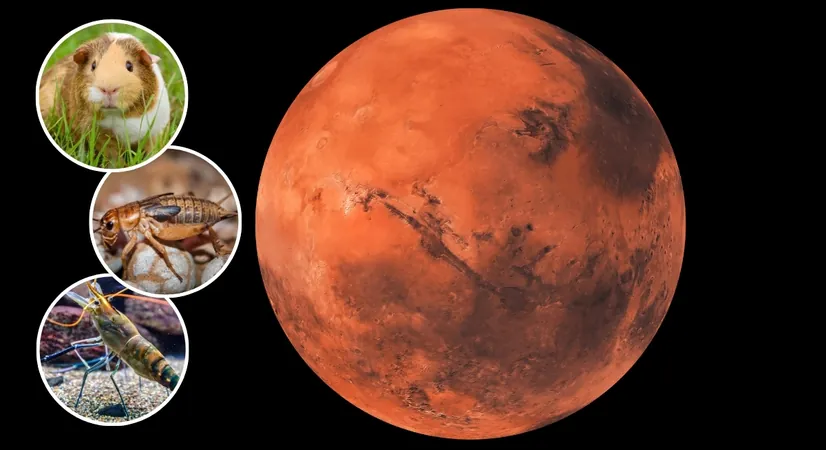
Meet the Pioneers: 15 Animals Set to Conquer Mars
2025-08-27
Author: Lok
As humanity sets its sights on Mars, the question arises: who will accompany us on this bold venture? To create a sustainable colony, we need tough organisms that can handle harsh conditions like intense radiation and minimal oxygen. Scientists have compiled a list of Earth’s resilient species that might thrive in Martian landscapes. Let’s explore the potential first settlers of the Red Planet!
1. Tardigrades: Space Survivors!
Tardigrades, tiny water bears, are renowned for their survival skills—they can withstand the vacuum of space, freezing temperatures, and extreme pressure. In their desiccated state, known as a tun, they halt nearly all biological functions, enabling them to survive for decades without food or water!
2. Leaf-Eared Mice: Masters of Harsh Environments
On the icy peaks of South America, researchers found leaf-eared mice thriving in conditions akin to Mars, proving their resilience. These mice not only endure freezing temperatures and low oxygen but thrive without human assistance!
3. Crickets: Tiny Protein Powerhouses
Raising livestock on Mars might seem daunting, but crickets are a game-changer. Requiring minimal water and thriving on leftover organic materials, they’re already being explored as a nutritious protein source. Whether in crunchy form or powdered, crickets could be a practical food choice in Martian habitats.
4. Lichens: Nature's Survivors
Lichens have proven their mettle by growing on rocks in extreme environments like the Antarctic and even space stations. Certain species, such as Cetraria aculeata, have shown they can remain active even under Martian-like conditions, making them excellent candidates for colonization.
5. Deinococcus Radiodurans: The Ultimate Survivor
Often dubbed 'Conan the Bacterium,' this enigmatic organism thrives in environments with radiation levels 25,000 times higher than humans can tolerate. With its remarkable DNA repair mechanism, it could potentially endure in Martian soils for millions of years!
6. Guinea Pigs: Versatile Companions
From livestock in South America to beloved pets elsewhere, guinea pigs could play multiple roles on Mars. They reproduce quickly, need little care, and offer valuable food and companionship. For settlers yearning for home, these furry friends could provide both sustenance and comfort.
7. Cyanobacteria: Oxygen Producers
These ancient microbes transformed Earth's atmosphere billions of years ago and are now being tested for Martian missions. Under the right conditions, cyanobacteria can produce breathable oxygen and enrich Martian soil, paving the way for future plant growth.
8. Shrimp: Aquatic Colonizers
Shrimp are prime candidates for aquaponics systems, where they can thrive in water, providing food while simultaneously recycling waste into nutrients for plants. Their protein-rich bodies and adaptability make them ideal for Martian food production.
9. Alpacas: Efficient Fiber Producers
Originating from the Andes, alpacas are well-adapted to high altitudes and thin air. Their minimal dietary needs and ability to produce valuable fiber for clothing and insulation make them fantastic neighbors in a Martian settlement.
10. Honeybees: Essential Pollinators
Pollination won’t occur naturally in Martian domes, making honeybees indispensable for agricultural success. These small but mighty insects have previously flown in space, suggesting that with careful management, they could thrive in Martian ecosystems.
11. Mealworms: Waste Transformers
Already used commercially on Earth, mealworms could play a critical role on Mars by converting organic waste into nutritious protein. These little recyclers could help close nutrient cycles in Martian habitats.
12. Algae: The All-in-One Superfood
Algae offer a powerhouse of possibilities—they can provide food, fuel, oxygen, and even filter water. Spirulina, in particular, can thrive in artificial lighting, making it a valuable asset for long-term Martian missions.
13. Chickens: Earthly Comforts
While raising chickens on Mars will present challenges, their efficient food-to-egg ratio could provide settlers with much-needed nutrition. Besides their meat and eggs, chickens could offer emotional support, creating a comforting connection to Earth.
14. Antarctic Krill: Potential Aquatic Ecosystem Builders
If humans manage to create oceans on Mars, Antarctic krill could emerge as early inhabitants. These crucial members of Earth's marine food web are resilient in cold waters and could help establish Martian marine ecosystems.
15. Mice: The Research Pioneers
For years, NASA has sent mice to space to study their biological similarities to humans. They adapt well to low gravity and provide valuable research insights, making them likely contenders to join us in the first Martian colony.
As we dream of life on Mars, these resilient creatures could play pivotal roles in ensuring humanity's survival beyond Earth, paving the way for a new chapter in our cosmic adventure.



 Brasil (PT)
Brasil (PT)
 Canada (EN)
Canada (EN)
 Chile (ES)
Chile (ES)
 Česko (CS)
Česko (CS)
 대한민국 (KO)
대한민국 (KO)
 España (ES)
España (ES)
 France (FR)
France (FR)
 Hong Kong (EN)
Hong Kong (EN)
 Italia (IT)
Italia (IT)
 日本 (JA)
日本 (JA)
 Magyarország (HU)
Magyarország (HU)
 Norge (NO)
Norge (NO)
 Polska (PL)
Polska (PL)
 Schweiz (DE)
Schweiz (DE)
 Singapore (EN)
Singapore (EN)
 Sverige (SV)
Sverige (SV)
 Suomi (FI)
Suomi (FI)
 Türkiye (TR)
Türkiye (TR)
 الإمارات العربية المتحدة (AR)
الإمارات العربية المتحدة (AR)